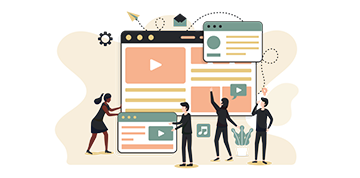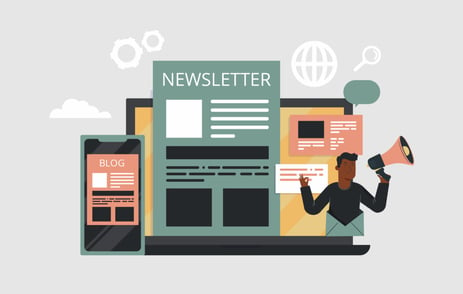If you’ve been following this series on AI-Generated Tagging, you’ll know that we’ve discussed the theory and potential of AI-generated tagging. Now we’re closing out the series by delving into the actionable steps. Think of this article as a the ultimate roadmap for implementing AI-generated tagging at YOUR association.
Without further ado, let's roll up our sleeves and explore the step-by-step process of implementation. By the end, you'll have a comprehensive understanding and a toolkit to bring this innovative approach to your association's content strategy.
Step 1: Content Audit and Goal Setting
Before diving into the technical steps of applying AI-generated tagging, it's important to take a step back and assess the current state of your content. Have you conducted a comprehensive content audit? If not, it would be a good place to start. What you would do is catalogue all the content pieces your association has, from articles and research papers to webinars and e-learning modules.
The goal here is to understand the volume, type, and distribution of your association’s content. Ask yourself questions like:
- Are there specific topic areas that are more densely populated than others?
- Are there gaps in topic coverage?
- Do outdated materials need to be updated?
Once you have a clear picture of your content landscape, set clear goals for your AI tagging initiative. Are you aiming to improve content discoverability? Enhance user experience on your website? Or perhaps streamline the content update process?
By setting clear and measurable goals, you'll have a benchmark to measure the success of your AI tagging implementation against. Remember, while AI is a powerful tool, its effectiveness relies on alignment with a well-defined purpose.
Step 2: Tool Selection and Budget Allocation
With a clear understanding of your content landscape and your goals in place, the next step is to choose the right AI tagging tool. As we've discussed in previous articles, there are plenty of options available, from commercial platforms to open-source solutions. Each option comes with its own set of features, capabilities, and price points.
Start by listing the essential features you think you might need. Consider factors, like:
- Do you require real-time tagging capabilities?
- Is integration with your current content management system a priority?
- How important is scalability as your content library grows?
- Do you have tech support on staff, or do you need support from the tool itself?
Once you've identified your must-haves, your action-item is to research and shortlist tools that align with these requirements.
Budget allocation is equally crucial. While some open-source solutions might be free, they could come with hidden costs related to customization, hosting, or maintenance. Commercial platforms, on the other hand, might have upfront costs but offer comprehensive support and regular updates. Balance your association's financial constraints with a tool's offerings to ensure you get the best value for your investment.
Step 3: Integration and Initial Setup
You've selected the ideal AI tagging tool for your association, so what’s next? Integrating your new tool into your existing content management infrastructure.
The specifics of this step will depend on the tool you've chosen, and may involve installing plugins, using APIs, or custom development work.
Engage your IT team or external technical partners to facilitate this integration. Ensuring that there's a clear line of communication between the tool providers and your technical team will help address any hiccups that might arise during the setup process.
Additionally, familiarize yourself with the tool's dashboard or interface. Most AI tagging tools come with a user-friendly interface that allows you to monitor the tagging process, view analytics, and make manual adjustments if needed. Spend some time exploring these features because a good understanding of them will empower you to make the most of the tool in the long run.
Step 4: Training and Calibration
AI, at its core, is a learning machine. While it's powerful, it often requires some initial guidance to perform optimally. This step involves "training" your AI tagging tool to understand the nuances and specifics of your association's content. Feed the tool a sample batch of your content and observe the tags it generates. Are they accurate? Relevant? Comprehensive? Basically, treat your new tool as a new employee. It needs time and feedback to adjust to the flow of your association.
In the initial stages, you might notice that the AI tool might not get everything perfect. That's okay! This is where calibration comes into play. Based on the tags generated, provide feedback to the tool. Some platforms allow for manual adjustments, where you can add, remove, or modify tags. As the tool receives more feedback, its accuracy and precision will improve, like a new employee.
Consider this phase as a collaborative effort between you and the AI. The goal is to fine-tune the tool so that it aligns perfectly with your association's content taxonomy and tagging preferences.
Step 5: Continuous Monitoring
The dynamic nature of content and the evolving capabilities of AI require ongoing attention. This step emphasizes the importance of continuous monitoring and establishing a feedback loop. Don’t worry, it’s not as daunting as it sounds!
Regularly review the tags generated by the AI tool. Are they still aligning with the content's essence? Are there any new trends or topics in your association's field that the AI might not be capturing? By keeping an eye on the tool's performance, you can ensure that it remains relevant and effective.
Additionally, consider involving your association's members and content consumers in this process. Set up a mechanism where users can suggest tags or provide feedback on existing ones. This not only enhances the accuracy of the tags but also fosters a sense of community involvement. Remember, the more data and feedback the AI receives, the more effective and accurate it becomes. By establishing this feedback loop, you're setting the stage for continuous improvement and ensuring that your AI-generated tagging system remains top-notch.
Step 6: Periodic Review and Tool Updates
As we know, the world of technology is always evolving, and AI is no exception. As advancements are made in the field of artificial intelligence and natural language processing, the tools and platforms we use will also change and improve. It’s important that your association stay up-to-date with these changes.
Set aside time, whether it be quarterly or bi-annually, to review any updates or enhancements to your new AI tagging tool. The tool's developers might release new features, improved algorithms, or integrations that can further optimize your tagging process. Ensure that you're leveraging these updates to maintain the efficiency and accuracy of your system.
Additionally, as your association's content library grows and diversifies, revisit your goals and objectives for AI-generated tagging. Are there new challenges or requirements that have emerged? Conducting periodic reviews will help you ensure that your AI tagging strategy remains aligned with your association's evolving needs and the latest technological advancements.
Implement AI-generated Tagging to Make Your Content More User-Centric
As we wrap up this series on AI-generated tagging for associations, it's evident that the journey to harnessing the power of AI is both exciting and transformative. While the steps we've outlined provide a roadmap, the true magic lies in the synergy between technology and the unique needs of your association. By embracing AI-generated tagging, associations stand to revolutionize their content management, making it more dynamic, accessible, and user-centric.
Remember, the world of AI is always evolving, and staying informed and adaptable is key. As you embark on this journey, know that the investment in time and resources will yield big results.
Thank you for joining us on this exploration of AI-generated tagging. Here's to a future where content is not just created but intelligently organized and effortlessly discoverable!
Tags:
Artificial Intelligence
September 28, 2023


